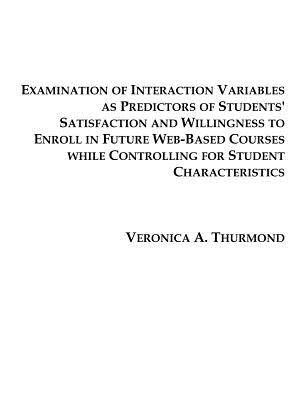
- We will send in 10–14 business days.
- Author: Veronica A Thurmond
- Publisher: Dissertation.Com. - Do Not Use
- ISBN-10: 1581121814
- ISBN-13: 9781581121810
- Format: 18.9 x 24.6 x 1.4 cm, softcover
- Language: English
- SAVE -10% with code: EXTRA
Examination of Interaction Variables as Predictors of Students' Satisfaction and Willingness to Enroll in Future Web-Based Courses (e-book) (used book) | bookbook.eu
Reviews
Description
Pub_AbstractText: The impetus for this study was the need to gain a better understanding of what interaction activities in the virtual classroom affect student outcomes. The purpose was to determine which perceptions of interactions contributed to predicting student outcomes of satisfaction and future enrollment in Web-based courses, while controlling for student characteristics. The problem is that the interaction that occurs in the Web-based classroom is markedly different than what occurs in the traditional classroom setting. The study was a secondary analysis using data from 388 student evaluations of Web-based courses. Using Astin's Input-Environment-Outcome (I-E-O) conceptual framework, influences of student characteristics [inputs] and virtual classroom interactions [environment] on student outcomes were examined. Student input predictors were perceptions of computer skills; knowledge of electronic communications; number of Web-based courses taken; distance living from campus; and age. Environmental predictors included interactions with the instructor, students, technology, and perceptions of presence.
EXTRA 10 % discount with code: EXTRA
The promotion ends in 20d.17:52:47
The discount code is valid when purchasing from 10 €. Discounts do not stack.
- Author: Veronica A Thurmond
- Publisher: Dissertation.Com. - Do Not Use
- ISBN-10: 1581121814
- ISBN-13: 9781581121810
- Format: 18.9 x 24.6 x 1.4 cm, softcover
- Language: English English
Pub_AbstractText: The impetus for this study was the need to gain a better understanding of what interaction activities in the virtual classroom affect student outcomes. The purpose was to determine which perceptions of interactions contributed to predicting student outcomes of satisfaction and future enrollment in Web-based courses, while controlling for student characteristics. The problem is that the interaction that occurs in the Web-based classroom is markedly different than what occurs in the traditional classroom setting. The study was a secondary analysis using data from 388 student evaluations of Web-based courses. Using Astin's Input-Environment-Outcome (I-E-O) conceptual framework, influences of student characteristics [inputs] and virtual classroom interactions [environment] on student outcomes were examined. Student input predictors were perceptions of computer skills; knowledge of electronic communications; number of Web-based courses taken; distance living from campus; and age. Environmental predictors included interactions with the instructor, students, technology, and perceptions of presence.


Reviews